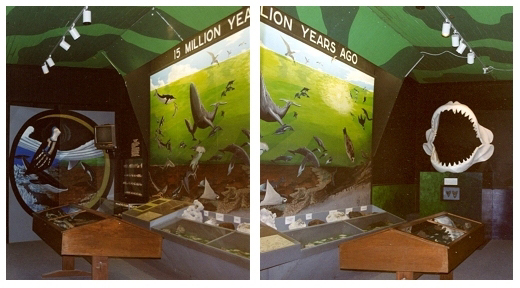

In a little-known town on the east coast of North Carolina hides a world class
fossil collection. The Aurora Fossil Museum in Aurora, N.C., holds thousands
of fossils found around the state over the past 30 years, including a one-million-year-old
intact walrus skull and quite a few megalodon teeth and bones.
The museum houses a wide variety of exhibits, including a mastodon tusk, several
shark teeth and shark jaws, mineral and gem displays, and a collection of Indian
artifacts including arrowheads and primitive tools and weapons.
Part of the shark exhibit. Photo courtesy
of the Aurora Fossil Museum.
"One of visitors' favorite aspects of the museum is the live dig site
out back," says Curtis Ormond, the museum's executive director. The dig
site is actually a pile of refuse from a nearby phosphate mine. Dump trucks
bring in 15-18 loads of the "reject material" at least once a month,
and visitors are encouraged to participate in their own discovery of the past
by digging through the fossil-rich pile. Ormond and other staff members provide
their own expertise and identification guides to aid hunters in identifying
their finds. "And of course they get to keep whatever they find,"
Ormond says.
The museum has a geologist on staff, and several others who volunteer their
time and expertise. Even the Smithsonian Institution pitches in occasionally,
especially during the annual fossil festival.
Each Memorial Day weekend, the Aurora Museum hosts the fossil festival where
numerous museums, including the Smithsonian, descend upon the town of 600 residents.
The museums set up displays, and experts from around the world come to discuss
recent fossil finds.
The museum, open since 1976, is dedicated to teaching the geology and geographical
history of eastern North Carolina, which millions of years ago was undersea.
Located on Main Street in downtown Aurora, the museum is looking to expand into
a larger building. "We hope to have a live pit someday too," Ormond
says. "One where visitors could see the actual formations from millions
of years ago."
One recent expansion is the new learning center located across the street from
the museum. Volunteer geologists teach classes — open to the public —
on various topics near and dear to the heart of the museum, such as primitive
weapons and fossils of eastern North Carolina during the Miocene, Pliocene and
Pleistocene.
The fossil festival is the most exciting time to visit the museum, Ormond says.
But he welcomes visitors any time of the year.
The museum is open Monday through Saturday, 9:00 a.m. through 4:30 p.m. Admission
is free, and school groups are welcome anytime, though they should call ahead.
Megan Sever
Links:
Aurora
Fossil Museum
Back to top
 |
Geotimes Home | AGI Home | Information Services | Geoscience Education | Public Policy | Programs | Publications | Careers |